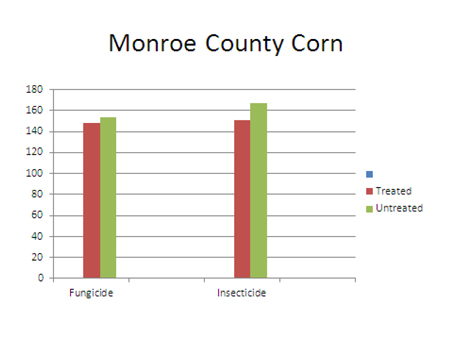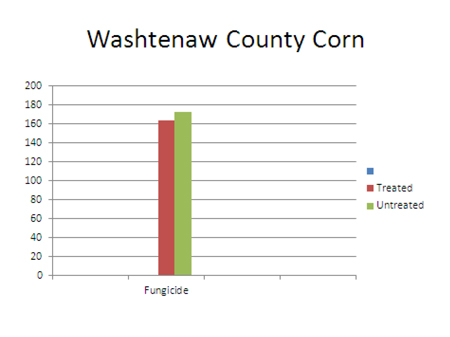2010 Corn foliar fungicide and insecticide project
Research in southeast Michigan will be continued to better determine the value of these applications.
Farmers in southeast Michigan are interested in obtaining higher corn yields. Chemical and fertilizer companies, and people such as Kip Cullers, have promoted the use of foliar products such as fungicides and insecticides to corn.
It is no surprise that farmers want higher yields. Scouting corn, particularly in the late vegetative and reproductive growth stages, is not one of the more fun tasks of the summer. Plant health, even without a lot of disease or insect pressure, is also mentioned as a benefit of foliar applied fungicides.
Several questions naturally arise during these discussions: Are leaf diseases or insects present? Do these products work, even without significant disease or insect pressure? Will using these products provide a yield increase? Does any profit from using these materials outweigh the expense? How can farmers apply post-emergent foliar products to corn?
One problem is that there is no uniform rating system for diseases among seed corn companies. What is tolerance? What is resistance? What is the difference? What are the major corn leaf or stalk diseases in southeast Michigan?
Plant health has been mentioned as a benefit of foliar applied products. Improvement in stalk health is typically tied to foliar disease control. Leaf disease control is also correlated with improved stalk health. Since foliar disease is the main driver of stalk health, farmers need to pay attention to leaf diseases. Corn root diseases are not typically a major problem in commercial corn that can be managed by foliar fungicides.
Corn insects are another issue, particularly since Bt corn products entered the market in 1996. European corn borers and the variant western corn rootworm have not been economic problems in southeast Michigan since the respective Bt corn varieties have been available to farmers. The newer western bean cutworm is a pest that bears watching as it moves eastward across the Cornbelt.
Can farmers manage leaf and stalk diseases?
There are many factors to consider, including:
- Variety susceptibility
- Weather including temperature, humidity and wind
- Tillage and residue
- Previous or continuous corn crop
- Irrigation
- Field history
- Scouting
Insects such as common stalk borer that bore into corn plants, can lead to stalk disease infection. Hail or wind can lead to stalk diseases. Animal feeding or damage can be another reason to look for subsequent diseases.
Some diseases, such as gray leaf spot or Gibberella ear rot, will overwinter in corn residue. However, primary tillage does not help as spores can blow in from neighboring fields. Diseases such as gray leaf spot, eyespot, northern corn leaf blight and common leaf rust can be managed with fungicides. Foliar fungicide application is the only management option to control some foliar diseases in corn after planting. Applied correctly, a foliar fungicide may reduce the impact of some foliar leaf diseases in corn.
Did we have diseases in southeast Michigan in 2010?
2010 was the worst year for anthracnose that I have seen in 31 years of county Extension work. This disease can affect over 300 types of plants ranging from flowers to trees. In corn last year, the upper corn leaves developed lesions and spots that elongated and turned entire leaves a tan color. Severely infected leaves on susceptible hybrids will wither and die within a few days. On resistant plants, the lesions are usually smaller. This fungus can also cause severe top dieback and stalk rot, which are considered to be more important causes of yield loss. Gray leaf spot, leaf rust and Northern corn leaf blight were also present on susceptible varieties.
For 2010, we worked with Syngenta using one product, replicated four times. Herb Smith hosted Monroe County plot and Jerry Kuhl was the Washtenaw County host. These were field-size plots, which meant that we only had enough room for one set of replicated treatments. In Monroe County, Quadris fungicide and Warrior insecticide were applied at the company-recommended V5 growth stage. In Washtenaw County, Quilt was applied at the R2 growth stage.

Treatments in Monroe County were made at the V5 growth stage, as recommended by the company. There were four replications of both the treated and untreated strips, which ran the length of the field. No statistics of significant differences were run since there is only one location and one year of data. At this growth stage, no leaf or stalk diseases were noted. As of the treatment date of June 25, there were no corn insect problems.

Only a fungicide treatment was made in Washtenaw County at the R2 growth stage on August 2. In this particular situation, I was unable to get the custom applicator to come at the V5 stage. Therefore, Quilt was used at 14 ounces per acre, and the treatment was replicated four times. Anthracnose, leaf rust and Gray leaf spot were observed in this field later in the season, but not at threshold levels. The corn variety used was a Rupp 101-day corn in which the company rated it “good” for “staygreen” and “excellent” for stalk strength.
In summary, for 2010, with one year of data and in only two locations, there was not enough data to show that the treatments offered measurable benefits. Both host farmers have agreed to conduct this trial again in 2011 as this project has been approved for 2011 and 2012 in southeast Michigan.



 Print
Print Email
Email




